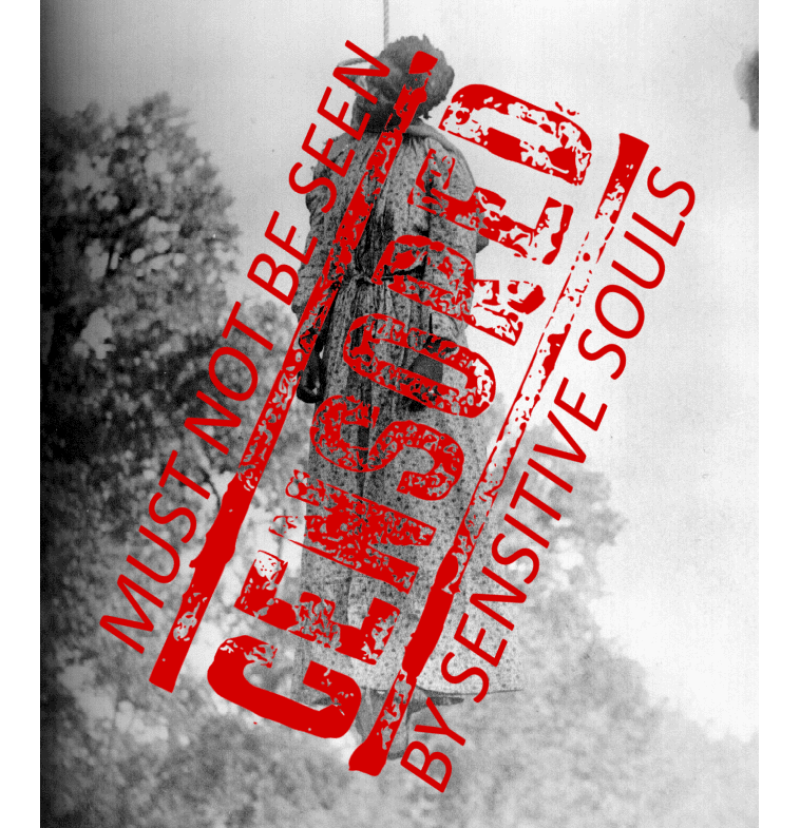A Museum That Makes White Liberals See the Horror of White Supremacy


I went to Montgomery , Ala., to visit the Legacy Museum and the National Memorial for Peace and Justice , two new spaces commemorating the history of systemic racism in this country, but I didn’t truly believe they were meant for people like me. Surely they were aimed at other people — white people who can’t or won’t see the culture of white supremacy that surrounds them, and black people whose experience of this wrenching history is finally being documented and ratified.
I was wrong.

Montgomery was the first capital of the Confederacy and the center of an immense domestic slave trade. The Legacy Museum , which stands at the site where slaves were imprisoned before being auctioned, follows history “from enslavement to mass incarceration.” The museum is small, but its mix of meticulously researched displays — both the high-tech (holograms of 19th-century slave and 21st-century prison narratives) and the simple (a wall of jars, each containing soil from the site of a documented lynching) — offer a stark view of American history, from slavery to segregation to persistent sentencing inequities and voter suppression . It is nothing less than a narrative history of American racism.
The hallway leading from the museum’s lobby to its first exhibit is a black tunnel that slopes downward to facsimiles of cells. Inside each one, holograms tell stories of life under slavery. “Mama?” one tiny boy calls into the darkness. You have to step close to the bars to hear him.
Another display is a seemingly everlasting slide show listing some of the more than 4,000 African-Americans known to have been lynched between 1877 and 1950. Their “crimes” included refusing to run an errand for a white woman, asking a white woman for a drink of water and rejecting a white man’s bid for cottonseed. These lynchings weren’t committed solely in the former states of the Confederacy, either: Crowd-administered torture and execution also occurred in states like Ohio, New Mexico, Illinois, Kansas, Pennsylvania and others. In 1920, three African-American men were lynched before thousands of white people in Duluth, Minn .
If the Legacy Museum is an overwhelming immersion in careful data, the National Memorial for Peace and Justice , its companion space, is a direct blow to the gut. Both sites are the result of years of research by the Equal Justice Initiative , a legal nonprofit that works to end racial and economic injustice, particularly in connection with mass incarceration.
When the memorial, which occupies six acres at the top of a hill overlooking downtown Montgomery, opened in April, it received considerable national attention. But nothing I read prepared me for my own emotional response to it.
The centerpiece of the open-air site is a collection of more than 800 steel columns. Each is roughly the dimension of a coffin and designed to run with blood-colored rust in the rain. Each bears the name of an American county and the names and death dates of the victims who died violently there.
There is no ignoring how personal this history is. My grandfather was 19 when two black men named Juster Jennings and Sills Spinks were lynched in his Alabama county in 1920. I couldn’t help myself: After seeing the column with their names, I had to look up the distance between the place where they were lynched and my grandfather’s farm. I felt a perverse amount of relief when I realized it was almost certainly too far for him to have traveled by mule.
But I had to admit that I couldn’t honestly say whether my grandfather would have wanted to be there. By the time I knew him, he treated everyone courteously. But he also asked my grandmother to stop teaching when Alabama schools were finally integrated (she didn’t stop). So I just can’t say.
Here’s the truth about the ubiquity of racism: I’m 56 years old, and there’s a bleeding column in that memorial for every place I’ve ever lived.
The sheer numbers are devastating, but it’s their placement that works most powerfully to convey the magnitude of loss. They are mounted at eye level as visitors first enter that part of the memorial, but as the floor slopes downward, the columns begin to rise. About halfway down the walkway, looking up and straining to read the engraved names, visitors suddenly realize that they are standing beneath a representation of bodies that have been hung from nooses and left to dangle there.
“God, they just go on and on,” I whispered to my husband. A black man standing nearby turned and looked at me. I couldn’t read his expression.
Heading back toward Nashville on Interstate 65, I noticed a giant battle flag of the Confederacy flying on the side of the highway outside Verbena, just north of Montgomery. I could swear I’d never seen that flag before, though I grew up in Alabama and though I’ve driven the length of that state during each of the past four summers. I wondered if the flag’s flagrant placement, so close to Montgomery, was an in-your-face rebuke to the presence of the Legacy Museum and the National Memorial for Peace and Justice.
Then I looked it up. Turns out the flag was raised in 2005 by the Alabama division of the Sons of Confederate Veterans. I just hadn’t noticed it before.


So, is there widespread "systemic" racism in American today? Or just scattered and isolated cases of racist groups or individuals??
Obviously.
Please provide evidence of such.
"If you don't see the problem, then you are part of the problem."
So you got nothing.
I'm not going to "discuss" this. It's not open to debate. If you refuse to see White Privilege, then you are a contributor.
Ok. The line you quoted, isn't me. YOU said it. Recommend you make the correction.
You actually think that I'm going to be guilt tripped into your racism? Think again. But I'll entertain you for just a minute, exactly HOW am I a contributor? And exactly what am I supposed to feel guilty for?
No one said you should feel guilty.
I am aware that I have benefited from White Privilege all my life. I think that is wrong, so I would like to see it end.
I did not cause the situation, so I don't feel guilty about anything.
You see?
If you do not recognize White Privilege, our society is such that you will inevitably contribute to it.
Thus... "if you do not see the problem, then you are part of the problem."
White liberals were abolitionists and opposed slavery. It was white conservatives who were the Dixiecrats that supported slavery and then racial segregation after the Civil war. Dixiecrats might have been economically aligned with the Democratic party but they were never socially liberal.
It's a historical accident. Lincoln was a Republican, so for a century it was unthinkable to vote Republican in the South.
The result was a Democratic Party with two completely different wings, the conservative racist Southern Democrats, and the liberal heirs to FDR elsewhere.
Exactly.
I grew up with George Wallace on the TV. I learned prejudice against a southern accent. LBJ was a social liberal... but... Vietnam...
Fifty years later, I still have presumptions when I hear a southern accent. Intellectually, I know that's wrong. But...
I grew up with a well educated white collar father who routinely said things that would have made Archie Bunker blush. I thought that was normal, until I was in high school and college. He was hardcore Republican and supported Nixon until the very end.
My father was an FDR Democrat who stated very clearly, "i don't like Black people." I have a cousin in Yuma, where all physically difficult work is done by "Mexicans", who speaks easily of "lazy Latinos".
Racism is endemic. Lots of people have no trouble at all ignoring the facts that are in front of their eyes, preferring to nurture their prejudices.
My whole family was racist as hell. I had to learn how not to be
I think that racism is a natural part of our character. We automatically mistrust "the other". But we're supposed to have moved along from our cave-dweller don't-trust-anyone-from-outside days.
If a bit of effort is required, then we must make that effort.
Racism and bigotry only exist because it dehumanizes the person, so talking to the supposed enemy and seeing them as human just like you I is the easiest way and is proven to succeed.
I suppose. By happenstance, I've never known a Black person well. Never closer than co-worker, where lots of racists function acceptably, hiding their true feelings.
Once past a first encounter, there's never been any difference.
I think the term racism is misused these days. Everything is labeled racism. Yes, there is certainly racism thriving under this President and through many of his cult followers but there is also racism within the black community against whites.
That's "bothsidesism", PJ.
Yes, of course... both sides do it...
But saying "both sides do it" when the power engaged and the consequences endured are so monstrously unequal is just plain wrong.
Better known as false equivalency, the right wing dingbats use it constantly, for actual defense of their side is pretty much impossible.
I agree it is not equal. Don't misunderstand my comment. But you can't speak to one without the other because they feed off each other .
If phenomenon A is insignificant while phenomenon B is important... we must not give them equal time.
Yes, the right tries to promote antifa to bugaboo status... but the fact remains that antifa has never killed anyone while the fascists kill frequently .
It is not true that "both sides feed off each other". One tries to stop killing. The other... kills...
Well we will have to agree to disagree on whether one feeds off the other. But I don't dispute that one side is killed more due to racism. It's incomparable.
As an example, my veiw about black people has changed dramatically when I was accused of racism at work last year. I won't go into specifics but after 9 months of investigations it was dismissed.
I may have subconsciously thought about race and gender prior to this incident but not the way I do now. There's your real time example of cause and effect. I'll be hiring 2 positions in the next 3 months. I think it's safe to say I won't put myself in that position again.
The real world isn't as simple as online...
Sounds like you came close to being a victim of racism PJ. It can be a real eye opener and I don’t blame you for taking steps to protect yourself from it happening again in the future.